THE HORIZONTAL STABILIZER
[09/23/2006]
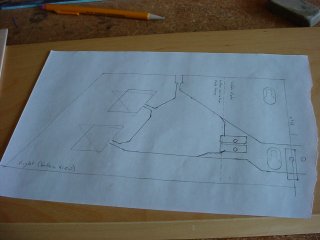 A good portion of this project has been focused on the design and development of the tail section.
Today, I completed the biggest step of the horizontal stabilizer assembly procedure: I laminated
the top and bottom pieces together!
A good portion of this project has been focused on the design and development of the tail section.
Today, I completed the biggest step of the horizontal stabilizer assembly procedure: I laminated
the top and bottom pieces together!
But before I did so, I made a map of the internal region, noting the route of every wire and the placement of the electrical contact points. I did this so I would have a permanent record, in case I ever need to make a repair or drill a hole for some reason in the future. I don't want to break something by accident later on (kind of like knowing where the gas line is before you dig a hole).
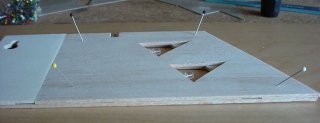 Here I was preparing to laminate the center section together. I secured the bordering laminates
down to ensure the proper placement of the center piece. This was the theory, anyway - you'll
see how things turned out soon enough.
Here I was preparing to laminate the center section together. I secured the bordering laminates
down to ensure the proper placement of the center piece. This was the theory, anyway - you'll
see how things turned out soon enough.
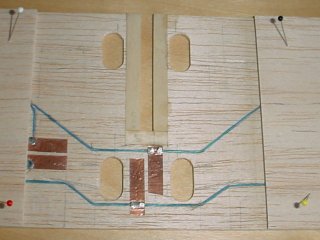 With the side laminates pinned in place, I removed the center section to expose the interior.
I cleaned the copper traces so that I could apply some solder to them for protection. This
would basically ensure that I would be able to attach wires to them later, as the solder would
prevent any glue from getting in the way, and also prevent the copper from becoming tarnished.
With the side laminates pinned in place, I removed the center section to expose the interior.
I cleaned the copper traces so that I could apply some solder to them for protection. This
would basically ensure that I would be able to attach wires to them later, as the solder would
prevent any glue from getting in the way, and also prevent the copper from becoming tarnished.
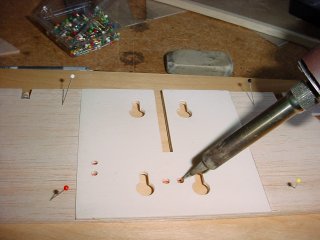 I put the center plate back in place and applied solder to the copper traces through the
pre-drilled holes. This ensured that I got the solder in just the right places, and provided
a last-chance opportunity to replace the copper in case something went very wrong before I
actually laminated the pieces together.
I put the center plate back in place and applied solder to the copper traces through the
pre-drilled holes. This ensured that I got the solder in just the right places, and provided
a last-chance opportunity to replace the copper in case something went very wrong before I
actually laminated the pieces together.
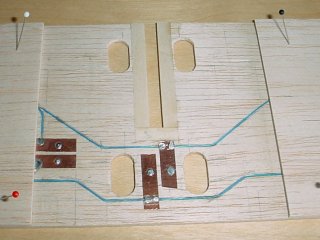 I removed the center plate once more to inspect the soldering work. Everything looked pretty
good, though I was mildly concerned about one solder blob being a little off-center. It also
had too much solder on it, so I cut it down a bit using the Dremel rotary tool. Everything seemed
to be holding up well, so I decided it wouldn't be a problem, and moved on.
I removed the center plate once more to inspect the soldering work. Everything looked pretty
good, though I was mildly concerned about one solder blob being a little off-center. It also
had too much solder on it, so I cut it down a bit using the Dremel rotary tool. Everything seemed
to be holding up well, so I decided it wouldn't be a problem, and moved on.
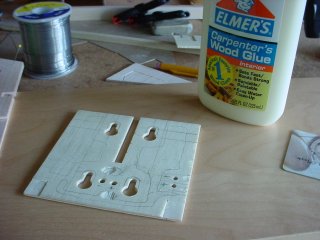 Meanwhile, I took the center plate and turned it over and marked the regions where I wanted to
apply the glue. I didn't want the glue to get into the areas of the electrical contact holes
or spill into the mounting hole regions, so I traced out a crude perimeter of approximately
where I wanted the glue to go. Then I applied the glue, spread it around to flatten it out
and distribute it evenly. I was pretty nervous at this point, because I knew this was a
critical step and was irreversible if it wasn't done right.
Meanwhile, I took the center plate and turned it over and marked the regions where I wanted to
apply the glue. I didn't want the glue to get into the areas of the electrical contact holes
or spill into the mounting hole regions, so I traced out a crude perimeter of approximately
where I wanted the glue to go. Then I applied the glue, spread it around to flatten it out
and distribute it evenly. I was pretty nervous at this point, because I knew this was a
critical step and was irreversible if it wasn't done right.
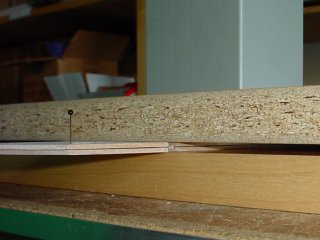 I pressed the plate down in place between two shelves, with a lead-acid battery sitting on top
to make sure it was flat. Unfortunately, something happened that I did not see when I glued a
couple of small test pieces together. The glue, being water based (I assume?), soaked into the
wood and made it swell a bit. It also created a tiny gap between the two layers simply by
virtue of taking up space, and also because the sides had been sanded thinner than the middle,
causing it not to sit down flush against the wood beneath it.
I pressed the plate down in place between two shelves, with a lead-acid battery sitting on top
to make sure it was flat. Unfortunately, something happened that I did not see when I glued a
couple of small test pieces together. The glue, being water based (I assume?), soaked into the
wood and made it swell a bit. It also created a tiny gap between the two layers simply by
virtue of taking up space, and also because the sides had been sanded thinner than the middle,
causing it not to sit down flush against the wood beneath it.
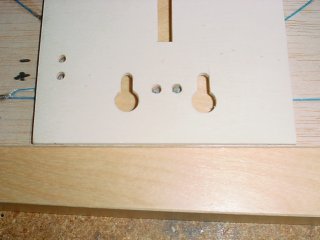 I was so worried at this stage that I was actually trembling. I had put so much work into this
thing to get to this point, and I was not about to start over...again! This would have been the
end of this project if recovery was impossible. While thinking about all the things that could
go wrong, I realized that the glue could seep out and cause the bordering laminates to become
stuck to the sides of the center plate, so I removed the weights, removed the bordering pieces
(that were holding the center plate in place) and put the weights back on top. When all was said
done, the center plate had wandered just a tiny bit after removing the bordering pieces, and you
can see that it doesn't exactly line up flush in the back. ARGH!!
Fortunately, the skew of the center plate wasn't enough to abandon the project.
I was so worried at this stage that I was actually trembling. I had put so much work into this
thing to get to this point, and I was not about to start over...again! This would have been the
end of this project if recovery was impossible. While thinking about all the things that could
go wrong, I realized that the glue could seep out and cause the bordering laminates to become
stuck to the sides of the center plate, so I removed the weights, removed the bordering pieces
(that were holding the center plate in place) and put the weights back on top. When all was said
done, the center plate had wandered just a tiny bit after removing the bordering pieces, and you
can see that it doesn't exactly line up flush in the back. ARGH!!
Fortunately, the skew of the center plate wasn't enough to abandon the project.
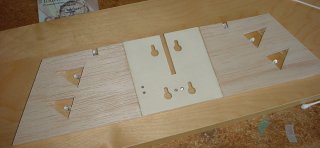 I was able to sand the edges of the bordering pieces to make them fit, and a little sanding after the entire
lamination process was complete would set things pretty much straight again. Close enough, anyway.
Hopefully. Anyway, I laminated the side pieces on and had a hell of a time with the first one,
because I used the wood glue and the layer warped like crazy due to swelling from glue absorption.
I quickly pressed down the edges flush and applied some instant CA glue (super glue). Problem
solved. I then stopped using the horrible wood glue and completed the final lamination using
gap-filling 15-second CA glue.
I was able to sand the edges of the bordering pieces to make them fit, and a little sanding after the entire
lamination process was complete would set things pretty much straight again. Close enough, anyway.
Hopefully. Anyway, I laminated the side pieces on and had a hell of a time with the first one,
because I used the wood glue and the layer warped like crazy due to swelling from glue absorption.
I quickly pressed down the edges flush and applied some instant CA glue (super glue). Problem
solved. I then stopped using the horrible wood glue and completed the final lamination using
gap-filling 15-second CA glue.
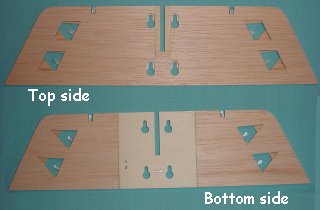 Once the lamination was complete, and I saw that it came out quite well, despite the nasty effects
of the wood glue (who told me to use that shit on balsa wood?), my nerves calmed down. It wasn't
the precision job I hoped it would be, but some precision sanding helps hide the flaws. The
horizontal stabilizer is now predominately complete, and I have sanded it to shape, but I still need
to sand the contour around the leading edges (round them off), attach the elevator control and sand
it to shape, and it will be ready for finishing and I can finally move on to the fin.
Once the lamination was complete, and I saw that it came out quite well, despite the nasty effects
of the wood glue (who told me to use that shit on balsa wood?), my nerves calmed down. It wasn't
the precision job I hoped it would be, but some precision sanding helps hide the flaws. The
horizontal stabilizer is now predominately complete, and I have sanded it to shape, but I still need
to sand the contour around the leading edges (round them off), attach the elevator control and sand
it to shape, and it will be ready for finishing and I can finally move on to the fin.
I am formulating my next steps, now, which should take me to the vertical stabilizer (fin) and then on to the tail boom. Lots of fun lay ahead! Oh, and I tested the lights in the horizontal stabilizer and they still work. WHEW!!! All systems are go, and all lights are green (except the LEDs in the airplane - they're red).
Keep an eye on my checklist, as I actually use it in the building process. If I am building, you can check frequently during the day to see my progress. Posting these reports typically takes a bit of time after I am done building, or while I am taking a break (or waiting for something to dry).